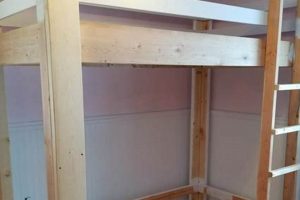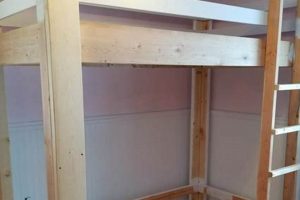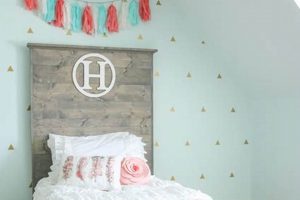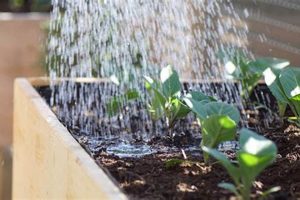A self-assembled cushioned panel designed for attachment to the bed frame, providing both aesthetic enhancement and comfort. This construction typically involves fabric, padding material, and a solid backing, often wood, to create a visually appealing and supportive headrest. The result is a personalized bed frame component offering the opportunity to customize the bedroom’s decor.
The construction and customization of such a panel offers significant advantages. It provides a cost-effective alternative to purchasing a fully assembled bed frame, while allowing for unique design choices that reflect individual preferences. Historically, headboards served primarily a functional purpose, shielding sleepers from drafts. Modern interpretations often prioritize aesthetics and comfort, leading to a surge in personalized design options. This approach empowers individuals to integrate personal style into their bedroom design.
The following sections will delve into the key aspects of building a custom cushioned bed panel, including material selection, construction techniques, and finishing touches to achieve a professional result.
Construction Considerations for Cushioned Bed Panels
The following provides practical guidance for ensuring a durable and aesthetically pleasing result when constructing a cushioned bed panel.
Tip 1: Material Selection: Prioritize high-quality materials. Opt for furniture-grade wood for the base to ensure structural integrity. Choose fabric resistant to wear and tear, considering factors like thread count and fiber composition. Padding should be dense and resilient, such as high-density foam, to maintain shape and comfort over time.
Tip 2: Precise Measurement: Accurate measurements are crucial. Measure the bed frame’s width meticulously to ensure the finished panel aligns correctly. Account for any overhang or specific design requirements. Double-check all measurements before cutting materials.
Tip 3: Secure Attachment: Implement a robust attachment method. Use appropriate hardware, such as heavy-duty bolts and brackets, to securely fasten the panel to the bed frame. Consider the weight of the finished panel and the stability of the bed frame when selecting attachment points.
Tip 4: Fabric Tension: Maintain consistent fabric tension during upholstery. Use upholstery staples or tacks to secure the fabric to the base, ensuring a smooth, wrinkle-free surface. Evenly distribute tension to prevent sagging or distortion over time. A staple gun is recommended for this step.
Tip 5: Edge Finishing: Pay attention to edge finishing. Conceal raw edges of the fabric and padding for a professional appearance. Techniques include using decorative trim, piping, or carefully folding and stapling the fabric to the back of the base. Mitered corners provide a cleaner look.
Tip 6: Padding Layering: Strategic padding layering enhances comfort and aesthetics. Begin with a layer of batting over the wood base to soften the surface. Add a thicker layer of foam for cushioning. Consider an additional layer of batting to smooth out any imperfections and create a plush feel.
Tip 7: Pattern Alignment: When using patterned fabric, carefully align the pattern across the panel. Plan the fabric layout to ensure a visually balanced and symmetrical design. Precise cutting and stapling are necessary to maintain pattern continuity.
These construction tips should enhance both the longevity and visual appeal of the finished panel. Attention to detail in each phase ensures a well-crafted addition to any bedroom.
The subsequent section will address common challenges faced during the construction process, along with effective troubleshooting techniques.
1. Material Selection
The selection of materials directly influences the structural integrity, longevity, and aesthetic characteristics of a self-assembled cushioned bed panel. The choice of frame material, padding, and upholstery fabric constitutes a critical early phase in the project. For instance, utilizing softwood for the frame may compromise long-term stability, leading to warping or breakage under stress. Conversely, a hardwood frame, such as oak or maple, provides greater resistance to deformation and supports the weight of the padding and fabric more effectively. Similarly, the selection of low-density foam padding can result in premature compression and loss of shape, diminishing the panel’s aesthetic appeal and comfort. High-density foam, however, maintains its form and offers superior support over time. The fabric choice also plays a significant role. Inexpensive fabrics may exhibit premature wear, fading, or tearing, requiring frequent replacement. Durable upholstery fabrics, such as linen or microfiber, withstand daily use and maintain their appearance for an extended period.
Consider a scenario where an individual opts for a particleboard frame, polyurethane foam padding, and a thin cotton fabric for a bed panel. Within a year, the particleboard may begin to sag, the foam loses its loft, and the fabric shows signs of wear. This illustrates the direct correlation between material quality and the finished product’s durability. Conversely, using a solid wood frame, high-density foam, and durable upholstery fabric results in a bed panel that retains its structural integrity and aesthetic appeal for many years. The initial investment in higher-quality materials translates to a longer lifespan and reduced maintenance costs.
In summary, material selection is a crucial determinant of the success and longevity of a custom-built cushioned bed panel. Compromising on material quality to reduce upfront costs often leads to premature failure and increased expenses in the long run. Therefore, a thorough evaluation of material properties, durability, and aesthetic characteristics is essential for achieving a satisfactory and lasting outcome. Neglecting this aspect introduces risks that can undermine the entire project, whereas careful selection fosters a durable and visually pleasing addition to the bedroom.
2. Frame Construction
Frame construction forms the foundational element of any self-assembled cushioned bed panel. The frame provides structural support for the padding and upholstery, dictating the overall shape and stability of the finished product. Poor frame construction directly impacts the panel’s durability and aesthetic longevity. For example, if the frame is constructed from inadequately sized lumber or joined with weak fasteners, it may warp or break under the weight of the padding and fabric, rendering the finished panel unusable. Proper frame construction, conversely, ensures that the panel remains structurally sound and visually appealing for an extended period.
The selection of appropriate joinery techniques is also crucial. Butt joints, while simple to execute, lack the strength necessary to withstand the stresses placed on a bed panel. Mitered corners, while aesthetically pleasing, require precise cuts and secure fastening to prevent separation over time. Mortise and tenon joints, although more complex to construct, provide superior strength and resistance to racking forces. Similarly, the use of pocket hole joinery offers a balance between ease of construction and structural integrity, particularly when reinforced with wood glue and screws. Real-world examples illustrate the importance of these construction details: a frame constructed with poorly executed butt joints may fail within months, while a frame built with mortise and tenon joints can last for decades.
In summary, frame construction represents a critical component of the self-assembled cushioned bed panel. Neglecting proper material selection, joinery techniques, or overall structural design can lead to premature failure and dissatisfaction. Attention to these details ensures a durable, aesthetically pleasing, and long-lasting addition to the bedroom. Challenges in this area can be overcome through careful planning, research, and the application of sound woodworking principles. The investment in robust frame construction ultimately translates to a higher quality and more valuable finished product, harmonizing with the broader theme of sustainable design and long-term value.
3. Upholstery Technique
Upholstery technique, in the context of constructing cushioned bed panels, directly dictates the aesthetic outcome, comfort level, and overall durability of the finished piece. Skilled execution ensures a smooth, wrinkle-free surface, proper fabric tension, and secure attachment, which contribute to the longevity and visual appeal of the headboard.
- Fabric Stretching and Securing
Even and consistent stretching of fabric across the frame is essential to avoid wrinkles and sagging. Securing the fabric, typically with staples or tacks, requires a firm grip and precise placement to maintain tension and prevent slippage. Uneven tension can lead to unsightly puckering, while improperly secured fabric can detach over time. The choice between staples and tacks influences the final aesthetic and ease of repair.
- Corner Treatment
Corners represent a particularly challenging aspect of upholstery. Different techniques, such as mitered corners, pleating, or folding, achieve varying aesthetic effects and levels of durability. Mitered corners offer a clean, streamlined look, but require precise cutting and sewing to avoid bulkiness. Pleating allows for more flexibility in fabric manipulation but can appear less refined. The selected corner treatment must complement the overall design and withstand repeated contact.
- Padding Layering and Contouring
The arrangement of padding layers significantly affects the comfort and visual fullness of the upholstered panel. Strategic layering, often involving batting, foam, and dacron, creates a smooth, contoured surface free from lumps or indentations. Proper contouring, particularly around edges and corners, enhances the aesthetic appeal and prevents premature wear. The type of padding material also influences the firmness and overall feel of the finished product.
- Decorative Detailing
Decorative elements, such as tufting, piping, or buttoning, add visual interest and sophistication to the upholstered panel. Tufting involves creating recessed areas in the fabric, which can be achieved through various techniques, each producing a distinct aesthetic. Piping defines edges and adds a tailored look, while buttoning secures fabric layers and provides a decorative focal point. The complexity of these details requires specialized tools and techniques to ensure a professional finish.
These facets of upholstery technique collectively define the quality and aesthetic of the finished cushioned bed panel. A mastery of these skills is essential for achieving a professional and durable outcome, transforming raw materials into a refined and comfortable addition to the bedroom. Inadequate execution in any of these areas can compromise the overall integrity and appearance of the bed panel, highlighting the critical role of upholstery technique in the construction process.
4. Design Aesthetics
Design aesthetics significantly influence the perceived value and overall impact of a self-assembled cushioned bed panel. The chosen aesthetic dictates not only the visual appeal but also how the headboard integrates with the existing bedroom decor. A poorly considered aesthetic can detract from the room’s overall harmony, while a well-executed design enhances its ambiance and perceived value. The selection of fabric, tufting patterns, and overall shape directly affects the headboard’s ability to complement the room’s existing style.
Consider, for example, a minimalist bedroom featuring clean lines and neutral colors. A tufted velvet headboard with ornate detailing would likely clash with this aesthetic, creating a jarring visual contrast. Conversely, a simple linen headboard with a clean, rectangular silhouette would seamlessly integrate into the minimalist design, enhancing its understated elegance. Similarly, in a bohemian-style bedroom filled with eclectic patterns and textures, a brightly colored, patterned headboard would reinforce the room’s vibrant and unconventional character. These scenarios underscore the importance of aligning the headboard’s design with the existing aesthetic context. Further, material choices impact perceived quality; the selection of luxurious fabrics and intricate design will improve its integration, while the opposite choices will harm it.
In conclusion, a focus on design aesthetics is not merely a superficial consideration but a fundamental aspect of creating a successful and visually pleasing self-assembled cushioned bed panel. Careful consideration of color, texture, form, and proportion, as well as their relationship to the existing bedroom decor, is essential for achieving a harmonious and aesthetically satisfying outcome. Neglecting this aspect can result in a headboard that detracts from the room’s overall appeal, while thoughtful attention to design aesthetics can elevate the entire space.
5. Attachment Method
The attachment method represents a critical juncture in the successful integration of a self-assembled cushioned bed panel with the existing bed frame. It determines the stability, safety, and long-term functionality of the combined structure. The chosen method must accommodate the panel’s weight, size, and design characteristics while ensuring a secure and aesthetically pleasing connection to the bed frame.
- Hardware Selection and Load Capacity
The selection of appropriate hardware, such as bolts, screws, and brackets, directly impacts the load-bearing capacity of the attachment. Hardware must be rated to withstand the weight of the panel and any additional forces applied during use. For instance, using undersized screws or flimsy brackets may result in the panel detaching from the frame, posing a safety hazard. Conversely, heavy-duty bolts and reinforced brackets provide a secure and reliable connection, minimizing the risk of failure.
- Frame Compatibility and Alignment
The attachment method must be compatible with the design and construction of both the bed panel and the bed frame. Consider the materials and dimensions of each component to ensure a proper fit. Misalignment or incompatibility can lead to instability and uneven weight distribution, potentially damaging the frame or panel. Careful measurement and planning are essential to ensure accurate alignment and a secure connection.
- Accessibility and Ease of Installation
The attachment method should allow for relatively easy installation and removal of the bed panel. Complex or cumbersome methods may deter individuals from attempting the project or make it difficult to adjust or reposition the panel. Consider accessibility for maintenance or repairs and choose a method that balances security with ease of use. Some methods are easier to install by yourself, while others require a second person.
- Aesthetic Integration
The attachment method should integrate seamlessly with the overall aesthetic of the bed panel and the bedroom. Exposed hardware or unsightly brackets can detract from the panel’s visual appeal. Concealing the attachment points or using decorative hardware can enhance the overall design and create a more refined finish. Aim for a solution that is both functional and visually unobtrusive.
Ultimately, the selection and execution of the attachment method are crucial determinants of the success of a “diy upholstered bed headboard” project. A well-chosen and properly implemented attachment method ensures a secure, stable, and aesthetically pleasing connection between the panel and the bed frame, contributing to the overall quality and longevity of the finished product. These factors must be evaluated to guarantee a satisfying and durable end result.
6. Dimensional Accuracy
Dimensional accuracy is a paramount consideration in the construction of a self-assembled cushioned bed panel. It directly affects the fit, finish, and overall aesthetic harmony of the finished piece within the bedroom environment. Precise measurements and adherence to those measurements are essential for ensuring that the panel aligns correctly with the bed frame and integrates seamlessly into the room’s existing design.
- Frame Dimensions and Bed Frame Compatibility
The accurate measurement of the bed frame’s width is fundamental. An improperly sized frame, even by a fraction of an inch, may result in the panel either failing to attach securely or protruding awkwardly beyond the frame’s edges. For example, a panel that is too narrow will leave unsightly gaps, while a panel that is too wide will interfere with bedside tables or other furniture. Consistency between the designed and executed dimensions is important to match existing room features.
- Fabric and Padding Material Calculations
Accurate calculations of fabric and padding material quantities are essential for cost-effectiveness and preventing material shortages. Underestimating fabric requirements can lead to visible seams or mismatched patterns, while overestimating results in unnecessary waste. Precise measurements of the frame’s surface area and thickness are necessary to determine the optimal amount of fabric and padding needed for a smooth, professional finish. Accurate measurements of materials are helpful in avoiding future replacements.
- Upholstery Seam and Edge Alignment
Precise measurements are critical for achieving uniform seam and edge alignment during the upholstery process. Inconsistent seam allowances or misaligned edges detract from the overall aesthetic and can compromise the structural integrity of the panel. Accurate measurements and meticulous cutting techniques are essential for creating clean, straight lines and preventing puckering or distortion of the fabric. In this respect, accuracy ensures long-term aesthetic appeal.
- Attachment Point Placement and Stability
The accurate placement of attachment points on both the bed panel and the bed frame is crucial for ensuring a stable and secure connection. Misaligned attachment points can lead to uneven weight distribution, causing the panel to wobble or detach from the frame. Precise measurements and careful drilling techniques are essential for creating a reliable and long-lasting attachment. Stability during attachment point creation is essential for longevity.
In conclusion, dimensional accuracy permeates every stage of the “diy upholstered bed headboard” construction process. From initial frame measurements to final attachment point placement, attention to detail and adherence to precise measurements are essential for achieving a successful and aesthetically pleasing outcome. Neglecting this aspect can result in a poorly fitting, unstable, and visually unappealing headboard, while meticulous attention to dimensional accuracy ensures a harmonious integration with the bed frame and the broader bedroom environment.
Frequently Asked Questions
The following addresses commonly encountered queries regarding the construction and implementation of upholstered headboards.
Question 1: What is the expected lifespan of a self-made upholstered headboard?
The lifespan varies depending on material quality and construction methods. A headboard built with high-quality materials and proper techniques can last for many years, potentially exceeding the lifespan of commercially produced alternatives. Neglecting material quality or sound construction practices may significantly reduce its lifespan.
Question 2: What tools are essential for this project?
Essential tools include a measuring tape, saw (circular or jigsaw), drill, staple gun, fabric scissors, and potentially a sewing machine if complex upholstery details are desired. Additional tools may be necessary depending on the specific design and construction methods employed.
Question 3: What type of fabric is most suitable for upholstery?
Durable, tightly woven fabrics such as linen, cotton canvas, or upholstery-grade synthetics are recommended. These materials offer resistance to wear and tear, and can withstand the stresses of daily use. Delicates fabrics should be avoided.
Question 4: How can one ensure fabric is properly stretched and secured during upholstery?
Consistent fabric tension is crucial. Begin by securing the fabric at the center of each side, then gradually working outwards, maintaining even tension to avoid wrinkles or sagging. A staple gun with adjustable power settings can assist in achieving secure and consistent attachment. Fabric clamps are helpful.
Question 5: Is sewing experience necessary for this project?
While not always essential, sewing experience can be beneficial, particularly for intricate designs or when creating custom piping or tufting details. Basic sewing skills can enhance the aesthetic appeal and overall quality of the finished headboard.
Question 6: How does one attach the finished headboard to the bed frame?
Attachment methods vary depending on the bed frame’s design. Common techniques include using bolts and brackets, or creating a French cleat system. The chosen method must provide a secure and stable connection, and should be carefully planned to ensure proper alignment and weight distribution.
Proper construction and material selection are crucial to achieving satisfying and long-lasting results.
The subsequent section will provide guidance on troubleshooting common problems encountered during headboard construction.
DIY Upholstered Bed Headboard
This exploration has underscored the multifaceted nature of self-assembling a cushioned bed panel. Material selection, frame construction, upholstery technique, design aesthetics, attachment method, and dimensional accuracy each represent critical elements influencing the final outcome. A comprehensive understanding of these areas is essential for achieving a durable, aesthetically pleasing, and structurally sound bed panel.
The commitment to meticulous planning, precise execution, and quality components translates directly into a lasting addition to the bedroom environment. While challenges may arise, the knowledge and strategies outlined provide a solid foundation for undertaking this project successfully, yielding a personalized furnishing that reflects both individual style and craftsmanship. Consider these principles carefully to guarantee a rewarding outcome.







